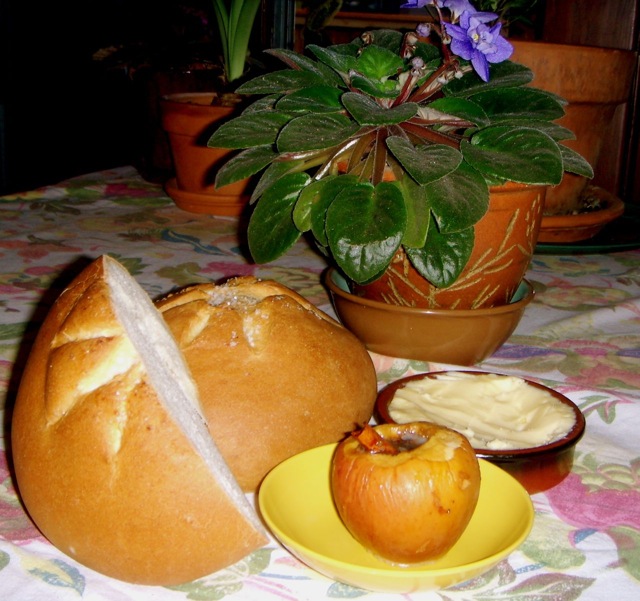
breakfast, l
(article, Harriet Fasenfest)
Yesterday I tried my hand at cheesemaking. As I write this, I have a half-gallon of slightly soured milk (nothing near a curd) sitting on a hot pad in my kitchen nook. I’ve already assessed the damage and will try turning the failed project into yogurt. I followed a recipe from a book in the old Time-Life series "The Good Cook" on cheese and eggs. I love that series. They have wonderful introductions and pictures along with information on ingredients and procedures that would rival many of today’s cookbooks. They can be a little hard to find, though, because they are out of print. I found a whole series at a library sale in Canby, Oregon, and was stoked by the score. [%image breakfast float=left width=350 caption="Homemade bread and butter, and an apple from the root cellar for breakfast. But no cheese this time."] Reading up on cheesemaking, my mind wandered on the path of “place and territory” again. Admittedly I am prone to do this, but this time I was aided by Time-Life. Cheese — from milk from cows or sheep or goats, from pastures, from summer or autumn grasses, from this or that farmstead particularly — was the literary subtext of cheesemaking. In fact, that is the subtext, or rather main text, of all cooking, at least as it started out. Today, even though the clear relationship between what grows and what ends up on the table is obscured by both industry and fashion, it can still be found. A case in point is Kookoolan Farms in Yamhill, Oregon. They sell their wonderful chickens and eggs at Portland-area farmers' markets. To get their milk, however, you need to get on a waiting list. I think I’m number 50. They are also the only outlet for cheesemaking supplies in the area. As for making cheese itself, it appears one has to add rennet (found in the stomachs of calves) because the enzymes naturally occurring in milk are destroyed in pasteurization. So we take the enzymes out, and then we put them back in. Farmstead cheeses, as they were enjoyed for centuries, were made from the raw milk (enzymes intact) of the animals, of the farm, of the grass, of the season, and of the particular technique of the farmer. Nowhere in that formula is high-temperature pasteurization. But then that, I suppose, is because small farms and their livestock and the milk they gave could be watched and tracked and cared for when needed. The milk from that farmstead did not mingle with milk from other farmsteads all over the countryside. In fact, when we think of industrialization, I’m not sure we can use the word "farmstead" at all. Industrial farms do not look like the pictures I see in Time-Life. You can do an end run around this debate of pasteurization, however, by making soft cheeses. Cheeses in that category (fresh mozzarella, ricotta, cottage, cream cheese, and others) come together very well with pasteurized milk. These cheeses are referred to as “acid-precipitated cheeses” and do not require rennet to form a curd. Most of the millions of recipes I found on the Internet suggested starting the curdling process by heating the milk and adding lemon juice or vinegar. The Time-Life recipe suggested using buttermilk to render a more subtle flavor. I also found lots of variances on time and technique. Some suggested bringing the milk to a boil, some suggested a simmer, and some suggested thermometers, while others suggested the process of their Lithuanian grandmas. What I understood from all these techniques is that farmer’s cheese is a staple of many homes and can be fairly easily made — except by me. But I'll keep on trying and report back.

breakfast, l